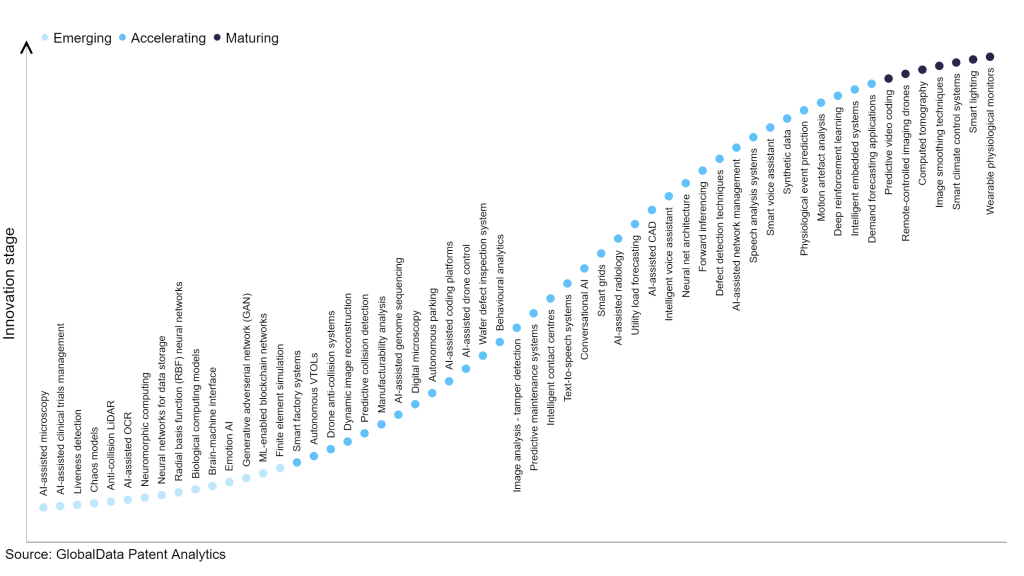The technology industry continues to be a hotbed of innovation, with activity driven by the widespread adoption of artificial intelligence (AI), Internet of Things (IoT) and smart home technologies, increasing demand for energy-efficient solutions, as well as the emphasis on sustainability and environmental conservation factors. This has resulted in the growing importance of technologies such as sensor networks, data analytics, connectivity protocols, and advanced control systems. These technologies contribute to improved energy efficiency, personalized lighting experiences, and greater convenience and comfort for users. In the last three years alone, there have been over 3.6 million patents filed and granted in the technology industry, according to GlobalData’s report on Innovation in Artificial Intelligence: Smart lighting. Buy the report here.
However, not all innovations are equal and nor do they follow a constant upward trend. Instead, their evolution takes the form of an S-shaped curve that reflects their typical lifecycle from early emergence to accelerating adoption, before finally stabilising and reaching maturity.
Identifying where a particular innovation is on this journey, especially those that are in the emerging and accelerating stages, is essential for understanding their current level of adoption and the likely future trajectory and impact they will have.
300+ innovations will shape the technology industry
According to GlobalData’s Technology Foresights, which plots the S-curve for the technology industry using innovation intensity models built on over 2.5 million patents, there are 300+ innovation areas that will shape the future of the industry.
Within the emerging innovation stage, finite element simulation, machine learning (ML) enabled blockchain networks and generative adversarial network (GAN), are disruptive technologies that are in the early stages of application and should be tracked closely. Demand forecasting applications, intelligent embedded systems, and deep reinforcement learning are some of the accelerating innovation areas, where adoption has been steadily increasing. Among maturing innovation areas are wearable physiological monitors and smart lighting, which are now well-established in the industry.
Innovation S-curve for artificial intelligence in the technology industry

Smart lighting is a key innovation area in artificial intelligence
Smart lighting refers to lighting technology that enables users to remotely adjust the brightness and colour of lights. It offers the ability to set desired moods and optimise energy efficiency. Integration with home automation systems allows users to conveniently control the lights using mobile devices or voice-controlled digital assistants, enhancing convenience and customisation options.
GlobalData’s analysis also uncovers the companies at the forefront of each innovation area and assesses the potential reach and impact of their patenting activity across different applications and geographies. According to GlobalData, there are 160+ companies, spanning technology vendors, established technology companies, and up-and-coming start-ups engaged in the development and application of smart lighting.
Key players in smart lighting – a disruptive innovation in the technology industry
‘Application diversity’ measures the number of different applications identified for each relevant patent and broadly splits companies into either ‘niche’ or ‘diversified’ innovators.
‘Geographic reach’ refers to the number of different countries each relevant patent is registered in and reflects the breadth of geographic application intended, ranging from ‘global’ to ‘local’.
Patent volumes related to smart lighting
Source: GlobalData Patent Analytics
Signify is a leading patent filer in field of smart lighting. One of the company’s patents describes a method that involves deploying a light source, such as a luminaire or lamp, that can emit light into an environment and be controlled through a first communication channel. Initially, the capability to control the light source through a second communication channel is deactivated. However, upon receiving a request to upgrade the light source after deployment, activation data is sent to enable electronic activation of the second communication channel for controlling the light source.
Other prominent patent filers in the space include Lutron Electronics and Alphabet.
By geographic reach, Compal Electronics leads the pack, followed by Merrytek Intelligent Technology and Squarex. In terms of application diversity, Signify holds the top position, followed by Intel and Lutron Electronics.
Artificial intelligence (AI) innovation in smart lighting is revolutionising the traditional lighting systems by integrating AI technologies to enhance efficiency, functionality, and user experience. Through AI algorithms and machine learning, smart lighting systems can automatically adjust lighting levels, optimise energy consumption, and respond to environmental factors such as occupancy and daylight.
To further understand how artificial intelligence is disrupting the technology industry, access GlobalData’s latest thematic research report on Artificial Intelligence (AI) – Thematic Intelligence.
Data Insights
From

The gold standard of business intelligence.
Blending expert knowledge with cutting-edge technology, GlobalData’s unrivalled proprietary data will enable you to decode what’s happening in your market. You can make better informed decisions and gain a future-proof advantage over your competitors.







